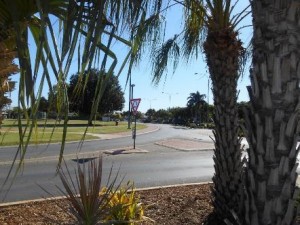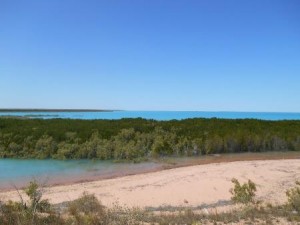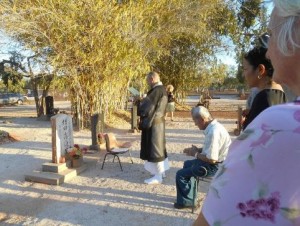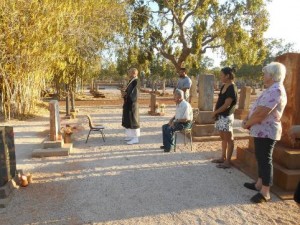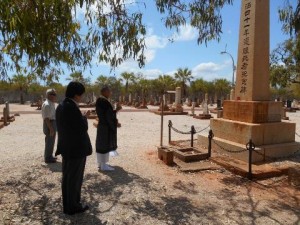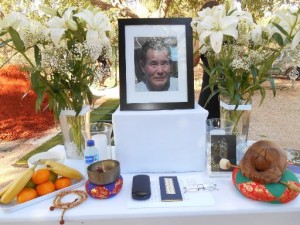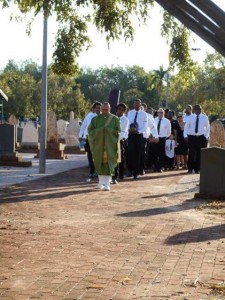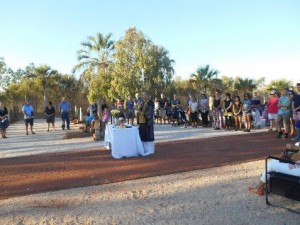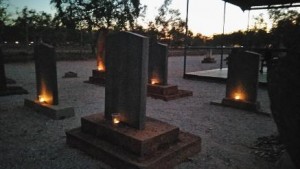
ブルーム日本人墓地でのお盆法要
[報告] 2017/1/10
オーストラリアの北西に位置するブルーム。ブリスベンからは約3000km、飛行機でおよそ4.5時間の距離です。今では真珠が有名ですが、昔は真珠貝の方に価値がありました。ブルーム周辺の海で、何世紀にもわたってアボリジニが真珠を採取していただけでなく、約1850年、そこに住み始めた初のヨーロッパ人も真珠貝を集め始めました。当時、真珠貝はボタン、ナイフやフォークのハンドル、ベルトのバックルや家具のはめ込み細工に使用されていて、とても高価な物でした(1トン当たり約400ポンド)。1883年、ブルームが市として認められ、小型帆船の本部となりました。真珠の80%はブルームからの物という、すぐに真珠業界で世界一の規模となりました。1910年には、400帆の真珠船とおよそ3500人もの人が真珠貝取集に携わっていました。皆様々な国から来ていて、ヨーロッパ、マレーシア、フィリピン、ティモール、中国、アボリジニ、日本からの人々です。
とてもマルチカルチャーな町でしたが、人種によって分かれていました。ヨーロッパ人は町の端に住み、アジア人はもう一方の端に住み、ジャップタウンと呼ばれていました。(第二次世界大戦後、チャイナタウンと改名されました。)それは、人種差別によるもので、日本人ダイバーは週に2ポンドの支給のところ、ヨーロッパ人は週に13ポンド。また、ボーナスでは日本人は8トンの貝につき40ポンド、ヨーロッパ人は1トンの貝につき40ポンドの支給があったのです。1901年には、オーストラリア政府が白豪主義を取り入れたことにより、更に人種差別が強まりました。これは、日本人の収入を低く抑えると同時に日本人が持つ帆船の数を少なく抑える事となりました。それにもかかわらず、1913年までには、1166人の日本人が労働しており、白人はいなくなりました。その結果として、ブルームにおいては白豪主義ポリシーは免除せざるを得なくなりました。
とても厳しい生活を送っていたブルームに住む日本人は、主に和歌山県太地町からの移民でした。サイクロン、さめ、脚気、耳と肺の感染症、潜函病に直面し、多くのダイバ―が命を落としました。彼らは、ヨーロッパ人から隔離された日本人墓地に埋葬されました。そこには、数は少ないですが女性、子供も埋葬されていて、総数900以上の墓石があります。墓は友人や同僚、家族が作ったため、様々な形や様式で、多くは現地で作られています。中には少数ですが、御影石を用いて日本で作り、ブルームに送られた物も見られます。日本人で初めて埋葬されたダイバー、タナカ コウトウ氏(1893年)を筆頭に第二次世界大戦初期までに900人以上が埋葬されました。
多くのダイバーが現地の女性と結婚し、家庭を作りました。しかし、第二次世界大戦が始まると、日本人とその家族はブルームから連れ出され、収容所に入れられました。そして戦後、日本人は日本へ返され、妻や子供達はブルームへ戻され、結果的に離れ離れになりました。日本へ返されたダイバーもブルームへ戻ることは可能でしたが、プラスチックの開発と真珠業が下を向いたことが重なり、多くは日本に留まっていました。そのブルームに戻ってきた少数のダイバーの中の一人がマツモト家族でした。
2015年8月、幸運にもマツモト エリカさんと知り会うことができました。彼女は白人です。戦後、ブルームに戻ってきた日本人ダイバーの息子と結婚しました。彼女の夫は収容所で産まれました。日本人墓地にある、夫と夫の両親の墓掃除に来ていた彼女と偶然会いました。自己紹介をしあったのち、日本人墓地に座り込み、家族の歴史を伺うことができました。そして、他のダイバー、マツダ アキラ氏 85才も紹介してくれました。その日の午後、私は彼の妻と子供たちのために法事をしました。この時が、ブルームに住む日本人コミュニティと接点を持つ初めての機会だったので、とても嬉しく思っていました。そしてその翌日、小規模ではありますが、マツダ氏とパースの日本領事と共に日本人墓地でお盆法要を施し、一緒に昼食をし、もっと多くの日本人コミュニティと知り合うことができました。
マツダ氏の法事をするまで、日本人墓地が日本人コミュニティに今でも使われているとは思いもしなかった私でしたが、今、まさに1950年代にブルームに渡った日本人ダイバーの第二の波が来ています。マツダ氏もその中の一人で、1955年に来豪しました。去年までは4人いましたが、あいにく今年5月、一人亡くなってしまいました。塩地逸氏、75才です。彼の娘、マヤさんから葬儀の依頼がありました。
塩地氏の葬儀には200人近い人の参列がありました。儀式は夕方から始まりました。というのも、日中はとても暑いからです。塩地氏の妻から、日本の葬儀で、故人はどうなるのかの説明をお願いされたため、極楽往生と阿弥陀様の慈悲について話しました。参列者は謹聴していました。私が話し終えてから、塩地氏のお棺が穴へ奥深く置かれ、真珠の貝が一緒に並べられました。この穴は、家族や友人たちによって掘られました。そして参列者が順番に穴を埋めていき、最後には女性らが白い砂で覆った赤土の山になりました。これは私自身も見たことがない土葬の一種で、ブルーム特有のものです。
葬儀ののち、皆が集まり、食事をしながら塩地氏の人生を祝いました。その時、日本人コミュニティから真珠祭りについての不満を聞きました。
真珠祭りというのは、毎年9月に催されるブルーム最大のお祭りです。1970年に日本のお盆、マレーシアの独立記念日そして中国のHang Sengの3つの文化が組み合わさってできました。3つのお祭りが合同しているため、ブルームの売り込みと観光の後押しを目的にブルーム市が指揮をとることになりました。その結果、残念ながら日本のお盆はなくなってしまったのです。伝統的にダイバーは、真珠貝を集めに3~5週間海へ出ます。そして、8月の満月、満潮の時に船がブルームへ帰ってくるのです。それから下船後、皆で墓地へ向かいお盆の法要をして盆踊りをするのです。
日本人にとって、とても重要であった最後のお盆が墓地で行われたのは、1969年が最後です。この話を聞いた時、とても悲しくなりました。そして私が8月にブルームへ来て一緒にお盆をすることを提案しました。皆が賛同してくれたので、今年8月18日、満月の日にブルームへ戻りました。お盆は16時半から始めました。予想より多い100人以上の参加があり、驚かされました。日本人コミュニティはもちろん、家族、友人、知人、学生に観光客までいたように思います。儀式の後、お盆についての説明をし、皆で墓石一つ一つの前にロウソクを灯しました。日が沈み徐々に暗くなると、ろうそくの火がとても綺麗で、感動的な光景でした。
このように、ブルームらしい伝統的なお盆が再びブルームへ返ってきたのです。
Broome is located in the north-west of Western Australia. It is about 3,000klm from Brisbane and takes about 4.5 hours to fly there. Now, it’s very famous for pearls but a long time ago pearl shell was more important. For centuries, the Aborigines had collected pearl shells from the sea around Broome. In about 1850, the first Europeans who settled in this area also began to collect the pearl shells. At that time, pearl shell was used for buttons, handles for knives, forks and spoons, belt buckles and inlay for furniture. It was very valuable (about 400 pounds per ton). In 1883, Broome was established and it became the headquarters of a fleet of pearling luggers. In a very short time Broome became the world’s largest pearling centre. 80% of the world’s pearl shell came from here. By 1910, there were 400 pearling luggers and about 3,500 people were working on the sea collecting pearl shell. These people came from many different countries. They were Europeans, Malaysians, Fillipinos, Timorese, Chinese, Aboriginal and Japanese.
It was a multicultural town, however, it was a segregated town. The Europeans lived in one end of the town and the Asians lived in the other end which was called Jap-town (renamed Chinatown after WW2). Because of racial discrimination, the Japanese divers were paid just 2 pounds a week while the white divers were paid 13 pounds a week. Also, Japanese divers were paid 40 pounds bonus for 8 tons of shell while white divers were paid 40 pounds for 1 ton. Further discrimination occurred in 1901, the Australian government started the White Australia Policy. This kept the wages of Japanese low and prevented them from owning luggers. But, despite this, by 1913, there were 1166 Japanese working on the luggers and no whites. Consequently, Broome became exempt from the White Australia Policy
The Japanese who came to Broome were mainly from Taiji, Wakayama Prefecture. Their life was very hard. They faced cyclones, sharks, beri-beri, ear and chest infections and the bends. Many Japanese divers lost their lives. They were buried in the Japanese Cemetery which was segregated from the European cemetery. There are also a small number of women and children buried there. In total there are more than 900 graves. The tombstones have a variety of shapes and styles because they were erected by friends, co-workers or family. Most are made from local sandstone but there are a few that are made from granite. These were made in Japan and sent to Broome. The first Japanese diver to be buried here was Tanaka Koto (1893). After him, a further 900 people were buried here until the beginning of World War 2.
Many of the divers married the local women and had families. But when World War 2 began, the Japanese and their families were taken from Broome and put into internment camps. Then, after the war, these families were separated. The Japanese were sent back to Japan and their wives and children were sent back to Broome. It was possible for the divers to return from Japan but because of the invention of plastic the pearling industry had declined and so many stayed in Japan. Among the few who stayed in Broome were the Matsumoto family.
In August 2015, I was fortunate in meeting Erica Matsumoto. She is a white person. She married the son of a Japanese diver who returned with his family to live in Broome. Her husband was born in the internment camp. Just by chance, I met her at the cemetery when she was cleaning the graves of her husband and his parents. I introduced myself to her and we sat down and talked for a long time about her family’s history. Later that day, she introduced me to another Japanese diver and his family. His name is Akira Masuda and he is 81 years old. It was decided that I would do a memorial service for his wife and his deceased children that afternoon. This was the first time that I was able to meet with some of the Japanese community in Broome. I was so happy. On the next day, I did a small Obon ceremony at the Japanese Cemetery with Mr. Masuda, his daughter and the Japanese Consular from Perth. After that we had lunch together and I was able to meet many more people from the Japanese community.
Until I did the memorial service for Mr. Masuda I had no idea that the Japanese Cemetery was still being used by the Japanese community. It is now mostly used by a second wave of Japanese divers who came to Broome in the 1950’s. Mr. Masuda was one of them and he came in 1955. There were four still living last year. But, unfortunately one died this year in May. His name is Itsushi Shioji and he was 75 years old. His daughter Maya asked me to do his funeral.
Mr. Shioji’s funeral was attended by almost 200 people. We began the ceremony late in the afternoon because it is very hot during the day. His wife asked me to explain to the mourners what happens in a Japanese funeral. I talked about Gokuraku Ojyo and Amida-sama’s compassion. The mourners listened very attentively. When I finished talking, Mr.Shioji’s coffin was lowered into a deep hole that had been lined with mother of pearl shell. This hole had been dug by his family and friends. The hole was then filled in by all the mourners taking turns. In the end there was a huge mound of red soil which the women covered with white sand. This kind of burial is a custom unique to Broome. I had never seen this before.
After the funeral, everyone gathered at a venue for food and drinks to celebrate the life of Mr. Shioji. It was then that I heard about the discontent that the Japanese community felt towards the Shinju Matsuri.
The Shinju Matsuri is one of the biggest events in Broome. It is held annually in September. It started in 1970 and it combined three cultural festivals, Japanese Obon, Malaysian Hari Merdeka and Chinese Hang Seng. By combining these cultural groups the Broome Council wanted to promote Broome and encourage tourism. Unfortunately, for the Japanese, Obon was lost. Traditionally, the divers would go to sea for several weeks to collect pearl shell. Then, the ships would return to Broome on the high tide of the full moon in August. After disembarking, they would go to the cemetery and hold an Obon ceremomy. After this, they would have food and drinks and Bon dancing.
In 1969, the last Obon was held in the cemetery and an important part of Japanese tradition and history ended. When I heard this story, I was saddened. So, I suggested that I could come to Broome in August and together we could hold an Obon ceremony. Everyone agreed with my suggestion. So, I returned to Broome on August 18, the day of the full moon. Obon started at 4:30pm. I was surprised to see so many people attend, perhaps more than 100. There were people from the Japanese community as well as their friends and also some students and tourists. After the ceremony, I explained the meaning of Obon and asked everyone to help light candles and place them in front of each grave. As the sun set and it gradually became darker, the graves lit by the candles looked beautiful. It was a very moving sight.
In this way, the unique tradition of Obon in Broome has been restored.
南無阿弥陀仏




